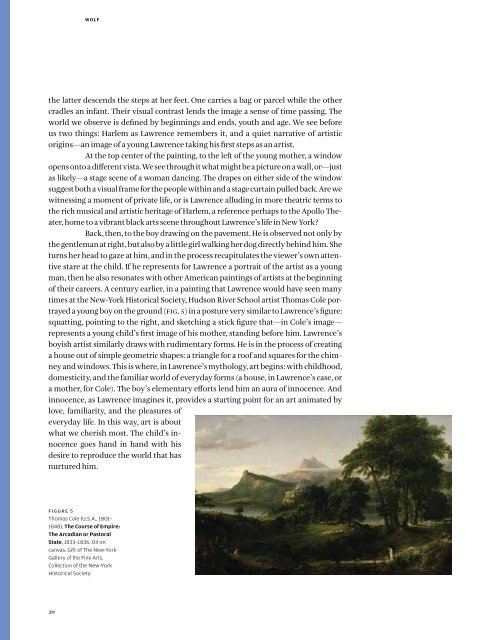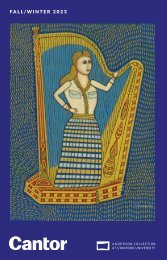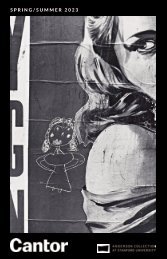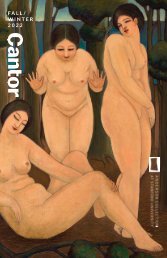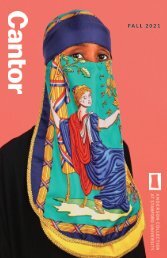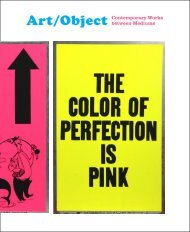Exhibition Catalog | Jacob Lawrence
Explore a gift of drawings, prints, and paintings by African American modernist Jacob Lawrence addressing Black history and civil rights, public life, faith, and creativity.
Explore a gift of drawings, prints, and paintings by African American modernist Jacob Lawrence addressing Black history and civil rights, public life, faith, and creativity.
Create successful ePaper yourself
Turn your PDF publications into a flip-book with our unique Google optimized e-Paper software.
WOLF<br />
the latter descends the steps at her feet. One carries a bag or parcel while the other<br />
cradles an infant. Their visual contrast lends the image a sense of time passing. The<br />
world we observe is defined by beginnings and ends, youth and age. We see before<br />
us two things: Harlem as <strong>Lawrence</strong> remembers it, and a quiet narrative of artistic<br />
origins—an image of a young <strong>Lawrence</strong> taking his first steps as an artist.<br />
At the top center of the painting, to the left of the young mother, a window<br />
opens onto a different vista. We see through it what might be a picture on a wall, or—just<br />
as likely—a stage scene of a woman dancing. The drapes on either side of the window<br />
suggest both a visual frame for the people within and a stage curtain pulled back. Are we<br />
witnessing a moment of private life, or is <strong>Lawrence</strong> alluding in more theatric terms to<br />
the rich musical and artistic heritage of Harlem, a reference perhaps to the Apollo Theater,<br />
home to a vibrant black arts scene throughout <strong>Lawrence</strong>’s life in New York?<br />
Back, then, to the boy drawing on the pavement. He is observed not only by<br />
the gentleman at right, but also by a little girl walking her dog directly behind him. She<br />
turns her head to gaze at him, and in the process recapitulates the viewer’s own attentive<br />
stare at the child. If he represents for <strong>Lawrence</strong> a portrait of the artist as a young<br />
man, then he also resonates with other American paintings of artists at the beginning<br />
of their careers. A century earlier, in a painting that <strong>Lawrence</strong> would have seen many<br />
times at the New-York Historical Society, Hudson River School artist Thomas Cole portrayed<br />
a young boy on the ground (fig. 5) in a posture very similar to <strong>Lawrence</strong>’s figure:<br />
squatting, pointing to the right, and sketching a stick figure that—in Cole’s image—<br />
represents a young child’s first image of his mother, standing before him. <strong>Lawrence</strong>’s<br />
boyish artist similarly draws with rudimentary forms. He is in the process of creating<br />
a house out of simple geometric shapes: a triangle for a roof and squares for the chimney<br />
and windows. This is where, in <strong>Lawrence</strong>’s mythology, art begins: with childhood,<br />
domesticity, and the familiar world of everyday forms (a house, in <strong>Lawrence</strong>’s case, or<br />
a mother, for Cole). The boy’s elementary efforts lend him an aura of innocence. And<br />
innocence, as <strong>Lawrence</strong> imagines it, provides a starting point for an art animated by<br />
love, familiarity, and the pleasures of<br />
everyday life. In this way, art is about<br />
what we cherish most. The child’s innocence<br />
goes hand in hand with his<br />
desire to reproduce the world that has<br />
nurtured him.<br />
FIGURE 5<br />
Thomas Cole (U.S.A., 1801–<br />
1848), The Course of Empire:<br />
The Arcadian or Pastoral<br />
State, 1833–1836. Oil on<br />
canvas. Gift of The New-York<br />
Gallery of the Fine Arts.<br />
Collection of the New-York<br />
Historical Society<br />
20


